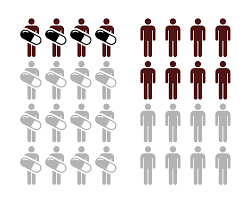
Measurement Scales/Variables, Measurement, and Statistics
Order Instructions:
SECTION A (1.5pages)
Measurement Scales
Quantitative analysis requires the use of numeric data to describe and interpret the results. The types of numeric data collected will determine what statistics can be utilized.
1. Please provide a definition of the nominal, ordinal, interval, and ratio scales and develop a simple chart with an example of each and specifying the types of statistics that might be used with each as follows:
Type of Data Example Statistical Procedure
Nominal (provide definition)
Ordinal (provide definition)
Interval (provide definition)
Ratio (provide definition)
2. Conclude your discussion with a reflection on how statistics might be utilized in your own evidence-based practice.
3. Provide at least three citations with full references to credible nursing scholarly articles supporting your definitions and discussion.
SECTION B (1.5pages minimum)
Variables, Measurement, and Statistics
A nurse has decided to research the following PICOT question: “Adult clients who are admitted to the cardiac unit with congestive heart failure are more likely to develop nosocomial infections than other cardiac clients admitted to the cardiac unit.” A quantitative research design is planned for this Project.
1. From the PICOT question, determine the following:
a. Identify the variables
b. Identify the levels of measurement of each variable
c. Identify the statistical test(s) to be used.
2. Provide at least three citations with full references to credible nursing scholarly articles supporting your definitions and discussion.
Resources to be used for each of the sections
• Coughlan, M., Cronin, P., & Ryan, F. (2007). Step-by-step guide to critiquing research. Part 1: quantitative research. British Journal Of Nursing, (BJN), 16(11), 658–663.
• Giuliano, K., & Polanowicz, M. (2008). Interpretation and use of statistics in nursing research. AACN Advanced Critical Care, 19(2), 211–222
• Ingham-Broomfield, R. (2008). A nurses’ guide to the critical reading of research. Australian Journal of Advanced Nursing, 26(1), 102-109.
From your textbooks, read:
Introduction to Nursing Research Incorporating Evidence-Based Practice
• Chapter 8: “Quantitative Design”
• Chapter 12: “Data Analysis”
• Chapter 13: “Critique Process”
SAMPLE ANSWER
Measurement Scales/Variables, Measurement, and Statistics
Section A
| Types of data | Example | Statistical procedure |
| Nominal | Hair color | Mode for central tendency |
| Ordinal | How do you feel? | Mode and median |
| Interval | Celsius temperature, time | Arithmetic mean, median, mode, standard deviation, and range |
| Ratio | Height and weight | Arithmetic mean, median, mode, harmonic mean, geometric mean, studentized range, and coefficient of variation. |
Nominal scales are utilized for labeling variables in the absence of quantitative value. They can simply be referred to as labels or names. The scales have no overlap or are mutually exclusive and none has numerical significance.
Ordinal scales; the order of values is more significant and important. However, the variation between each one is unknown. These are typically non-numeric concepts’ measures such as discomfort, happiness, and satisfaction. These can be easily remembered through the word ‘order’. The mode and median are the best when determining the central tendency is an ordinal data set (Moorhead, 2013).
Interval scales; there are numeric scales where the order as well as the exact variations between values is known. The statistical analysis realm on the data sets opens since the mean, median, statistical deviation, and mode can be calculated. These scales have no true zero and this makes it impossible to calculate the ratios (Moorhead, 2013). For instance, there is no time or no temperature. With the interval data, one can subtract and add but cannot divide or multiply. The key thing to remember in interval scales is the interval, which implies the space in between.
Ratio scales are acknowledged as the overall as far as the measurement scales are concerned. This is because they tell about the order, exact values between units, and possess an absolute zero that permits the application of a wide array of both inferential and descriptive statistics. Ratio scales also have a vivid definition of zero. Ratio scales offer a wealth of possibilities as far as statistical analysis is concerned. With these variables, it is possible to add, subtract, multiply, and divide. It is also possible to measure the mean, median, mode, coefficient of variation, and measures of dispersion (Ingham-Broomfield, 2008).
How statistics can be used in evidence-based practice
Recently, evidence-based practice has become very essential in healthcare. In this regard, there is a need for healthcare professionals to be aware with the practice, how to use it, and its significance in guarding patient safety. More specifically, the Obama Administration is dedicated to policy decisions that are guided by evidence. In this regard, there should be a greater promotion of statistics use as well as the statisticians’ role in making proper decisions that are founded on objective evidence. Evidence-based medicine refers to the explicit, conscientious, and judicious use of the current best evidence when making decisions on individual patient care. The practice of using evidence-based medicine implies integrating personal clinical experience with proper available clinical evidence from external sources (systemic research). In this regard, statistics is fundamental to the evidence-based medicine (Moorhead, 2013).
It is worth pointing out that that evidence-based practice emerges from the most recent evidence. This implies the deep connection between recent research and the decisions being made in the healthcare practice. The statistics that are used in the research form the foundation of the strategies that will be implemented as well as the decisions that will be made. In this regard, the statistics and data should be trustworthy. This brings in the aspect of validity and consistency of data. If possible, only statisticians should be allowed to handle the data so as to ensure that the right procedures are being followed and that the data collected is proper. As a result, the evidence-based practice becomes more productive and applicable (Coughlan, Cronin & Ryan, 2007).
References
Coughlan, M., Cronin, P., & Ryan, F. (2007). Step-by-step guide to critiquing research. Part 1: quantitative research. British Journal Of Nursing, (BJN), 16(11), 658–663.
Ingham-Broomfield, R. (2008). A nurses’ guide to the critical reading of research. Australian Journal of Advanced Nursing, 26(1), 102-109.
Moorhead, S. (2013). Nursing outcomes classification (NOC): Measurement of health outcomes. St. Louis, Mo: Elsevier/Mosby.
Section B
The PICOT format in clinical questions aims at ensuring that researchable and answerable questions are developed (Melnyk & Fineout-Overholt, 2011). P (patient population), I (issue of interest or intervention), C (comparison issue of interest or intervention), O (outcomes of interest), and T (the time needed for outcomes to be achieved in the intervention) (Giuliano & Polanowicz, 2008).
‘Adult clients who are admitted to the cardiac unit with congestive heart failure are more likely to develop nosocomial infections than other cardiac clients admitted to the cardiac unit.’
Variables
Other cardiac patients and congestive heart failure patients. There are also variables of the cardiac unit and nosocomial infections.
Each variable’s levels of measurement
Cardiac patients- ordinal
Congestive heart failure patients- ordinal
Cardiac unit- nominal
Nosocomial infections- ordinal
Statistical tests
Based on the fact that there are only ordinal and nominal levels of measurement, it is impossible to have statistical tests such as mean, mode, and median. Therefore, there are high chances that the study being conducted was qualitative where no kinds of inferential and statistical tests are required (Boswell, Boswell & Cannon, 2014). The Ch-square, Fisher’s exact, and Wilcoxon- Mann Whitney tests will be used since there are independent variables.
Basically, the use of PICOT questions when carrying out evidence-based practice is very use. This promotes the development of answerable and researchable questions. This ensures that the evidence gathered is more applicable in the practice (Aveyard & Sharp, 2013).
References
Aveyard, H., & Sharp, P. (2013). A Beginner’S Guide To Evidence-Based Practice In Health And Social Care. Maidenhead: McGraw-Hill Education.
Boswell, C., Boswell, C., & Cannon, S. (2014). Introduction to nursing research: Incorporating evidence-based practice. Burlington, MA: Jones & Bartlett Learning
Giuliano, K., & Polanowicz, M. (2008). Interpretation and use of statistics in nursing research. AACN Advanced Critical Care, 19(2), 211–222
Melnyk, B. M., & Fineout-Overholt, E. (2011). Evidence-based practice in nursing & healthcare: A guide to best practice. Philadelphia: Wolters Kluwer/Lippincott Williams & Wilkins.
We can write this or a similar paper for you! Simply fill the order form!









